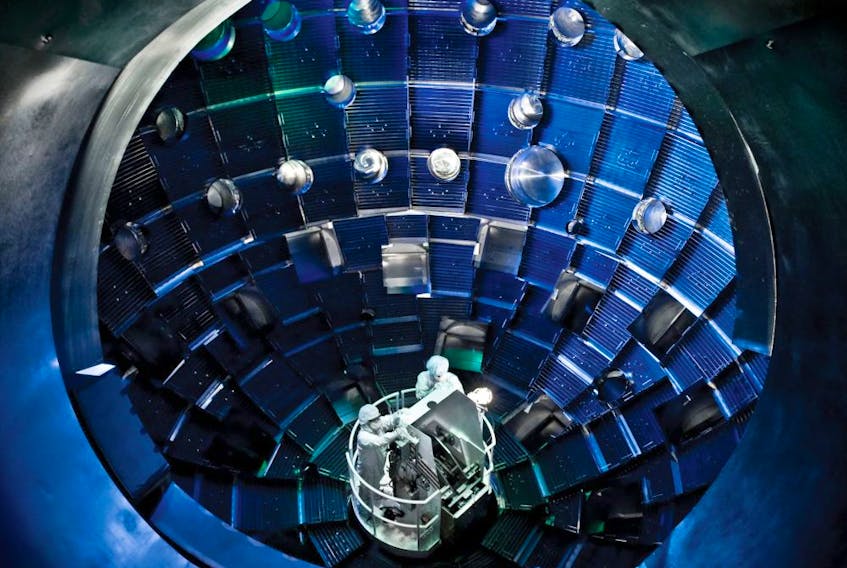Maybe you’re like me, you grew up on a steady diet of science fiction paperbacks and Omni magazine, and you would be absolutely thrilled to bits if it turned out that artificial thermonuclear fusion could be made a practical source of usable earthbound energy.
I use the word “artificial,” of course, to distinguish sophisticated experimental fusion projects from the solar panels on your nerd neighbour’s roof, which are, strictly speaking, capturing energy from a big yellow fusion reactor in the sky. Harnessing the power of an artificial sun has been a vision of engineers for more than 60 years; to some, it seems to offer the promise of limitless nuclear power without the problems of waste-producing fission reactors.
On Sunday, Tom Wilson the Financial Times got what is likely to be the biggest news scoop in the plodding, hype-fraught history of fusion experiments. According to Wilson, the National Ignition Facility (NIF) at the Lawrence Livermore National Laboratory in California has achieved the first energy-positive “shot” in the history of artificial fusion.
Researchers fired the world’s largest laser at a small deuterium-tritium target about the size of a BB round, persuaded the hydrogen in the pellet to fuse for a few billionths of a second and got more energy out of the resulting reaction than they put in via the laser beam. This “target gain,” if the NIF pulled it off, would be the proof-of-concept that fusion researchers have been chasing for decades, having found over time that confining even a very small sun was a lot harder than they originally thought.
If you believe that the future of humanity involves ubiquitous nuclear-fusion power plants producing energy too cheap to meter, then today’s expected announcement will be a great moment — the equivalent, arguably, of the first artificial fission reaction, which was completed under a football stadium at the University of Chicago 80 years ago this month.
But reading Tom Wilson’s scoop actually made me sadder than I would have expected from the vantage point of that young man consuming 1980s hype about tokamaks and hohlraums. The Bloomberg energy reporter Javier Blas published a Twitter thread that explains why very well.
The breakthrough of deriving “net power” from a fusion shot is mostly a matter of accounting fictions: the real question, as any bean counter would know in his heart, is “net of what?” The NIF may be the first fusion plant to generate power net of the energy fired into the chamber by an enormous, elaborately tuned laser. But this doesn’t even count the power lost in the charging of the capacitors that fire the big laser.
To be useful for commercial power production, those lasers would have to be capable of firing repeatedly without destroying the equipment used to measure the reaction — as the NIF shot is reported by Wilson to have done. The output of the plant would, over the long run, have to cover implicit energy inputs involved in doing things like creating tritium (a form of “heavy water” not existing in nature), cooling the target pellet to near-absolute zero before firing and, well, building the plant itself, every part of which seems to require micrometric engineering tolerances, exotic materials and mind-blowing temperature ranges.
It is hard to imagine anyone building a second NIF; the one that exists was really built to study nuclear explosions for military purposes, still the chief raison d’être of the Livermore lab. It has gone to a lot of trouble, one has to say, to “prove” that nuclear fusion is possible and produces net energy; both the sun and the original American fusion weapons can be used to demonstrate that much.
The question facing policymakers in 2022 is whether the problems of fission are really so great compared to the engineering challenges of trying to control fusion.
The basic question raised by conventional fission reactors is, “If we dig a really, really deep hole someplace geologically stable in order to store nuclear waste, is there a chance that an unknown species of molemen might get cancer?” Fusion asks, “Can you ignite a star and harness its output, preferably downtown?” I will grant that you have to be impressed that the human species’ answer to this question may now be: “Yes, you can, very, very briefly.”
National Post
Twitter.com/colbycosh
This column was originally published in the NP Platformed newsletter. Sign up here .
Copyright Postmedia Network Inc., 2022









